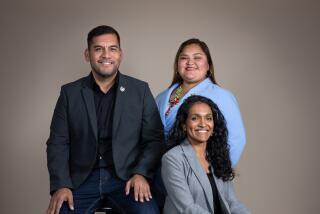Editorial: Take your time, Mayor Garcetti, and pick a winning CAO
When Los Angeles City Administrative Officer Miguel Santana announced last month that he was leaving to take a new job overseeing the Los Angeles County Fair, there was dismay in City Hall. As the city’s budget and policy analyst, Santana has helped guide city government over the last seven years from financial meltdown and near bankruptcy to relative fiscal stability, with Los Angeles about to make unprecedented investments to house the homeless, rebuild broken sidewalks and pave potholed streets.
Pragmatic and persuasive, Santana has urged elected officials to make hard but necessary choices, such as passing pension reform and laying off city workers during the depths of the recession. He’s also pushed them to be ambitious in solving some of the city’s thorniest problems, such as asking voters to approve a $1.2 billion bond to build permanent supportive housing for the homeless. And he’s been willing to risk the ire of the mayor and City Council with his reports, such as one that questioned the financial plan for the city’s bid to host the 2024 Olympics.
But worry in City Hall is about more than the loss of Santana’s steady hand. There is a real concern over whom Mayor Eric Garcetti will pick to follow him. Will the mayor choose a close ally or staff member — someone who might be less willing to give an honest assessment of the mayor’s initiatives? Alternatively, will the mayor pick a meek bureaucrat comfortable with the status quo, or someone whose advice could easily be ignored?
Councilman David Ryu has urged Garcetti and the council not to move fast in picking Santana’s successor. He called for a nationwide search to find an “independent candidate with the astute knowledge, leadership, and vision to advise the City’s policymakers.”
He’s right to call for a thorough search. The CAO is one of the most important jobs in city government, and it’s one of the few city offices that has duties spelled out in the charter. The CAO works with the mayor to draft the city budget and, more broadly, analyzes the costs and effectiveness of city policies and programs. Ideally, the CAO is an advocate both for fiscal responsibility and for efficient, transparent government. And the CAO is the city’s labor negotiator, responsible for hammering out a good deal for taxpayers with the city’s politically influential employee unions.
A good CAO, like Santana, is viewed as a reliable and impartial analyst and adviser. That’s important because the CAO serves three demanding masters: the mayor, the City Council and the public. And if the CAO is seen as too close to one, he or she loses credibility with the others and becomes less effective.
And Angelenos need an effective CAO. Last month, voters approved the Measure M sales tax increase for transportation, which will send millions of dollars to the city that could pay for street repairs, sidewalks and other infrastructure investments. And voters OK’d Measure HHH to spend $1.2 billion on housing for the homeless. The CAO will play an important role in overseeing how the money is spent and ensuring the city can deliver on its promises.
While L.A.’s finances have improved from the dark days of the recession, the city still has a structural deficit and still spends roughly 20% of its budget on pensions and retirement benefits, leaving fewer dollars for basic services and ambitious projects, like restoring the Los Angeles River. The mayor and City Council will continue to need solid financial advice from the CAO, and continued prodding to control costs.
Garcetti should take the time to find the best CAO possible, whether that requires a nationwide search or a thorough hunt for talent close to home.
Follow the Opinion section on Twitter @latimesopinion and Facebook
More to Read
A cure for the common opinion
Get thought-provoking perspectives with our weekly newsletter.
You may occasionally receive promotional content from the Los Angeles Times.










